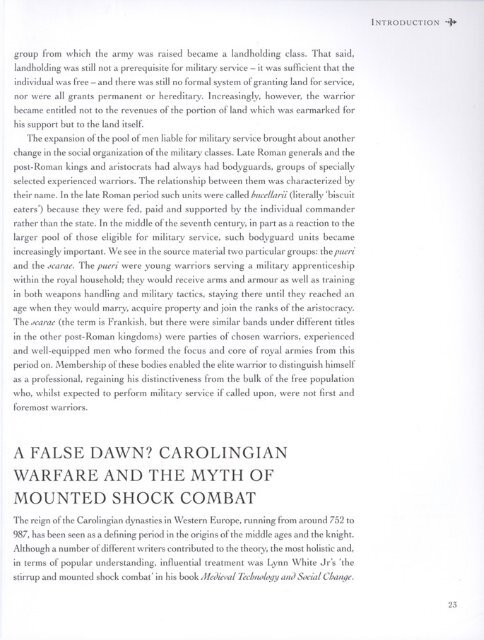Osprey - General Military - Knight - The Warrior and ... - Brego-weard
Osprey - General Military - Knight - The Warrior and ... - Brego-weard
Osprey - General Military - Knight - The Warrior and ... - Brego-weard
You also want an ePaper? Increase the reach of your titles
YUMPU automatically turns print PDFs into web optimized ePapers that Google loves.
group from which the army was raised became a l<strong>and</strong>holding class. That said,<br />
l<strong>and</strong>holding was still not a prerequisite tor military service — it was sufficient that the<br />
individual was free — <strong>and</strong> there was still no formal system of granting l<strong>and</strong> for service,<br />
nor were all grants permanent or hereditary. Increasingly, however, the warrior<br />
became entitled not to the revenues of the portion of l<strong>and</strong> which was earmarked tor<br />
his support but to the l<strong>and</strong> itself.<br />
<strong>The</strong> expansion of the pool of men liable for military service brought about another<br />
change in the social organization of the military classes. Late Roman generals <strong>and</strong> the<br />
post-Roman kings <strong>and</strong> aristocrats had always had bodyguards, groups of specially<br />
selected experienced warriors. <strong>The</strong> relationship between them was characterized by<br />
their name. In the late Roman period such units were called bucellarii (literally 'biscuit<br />
eaters') because they were fed, paid <strong>and</strong> supported by the individual comm<strong>and</strong>er<br />
rather than the state. In the middle of the seventh century, in part as a reaction to the<br />
larger pool of those eligible for military service, such bodyguard units became<br />
increasingly important. We see in the source material two particular groups: thepueri<br />
<strong>and</strong> the jcarae. <strong>The</strong> pueri were young warriors serving a military apprenticeship<br />
within the royal household; they would receive arms <strong>and</strong> armour as well as training<br />
in both weapons h<strong>and</strong>ling <strong>and</strong> military tactics, staying there until they reached an<br />
age when they would marry, acquire property <strong>and</strong> join the ranks of the aristocracy.<br />
<strong>The</strong> Ltcarae (the term is Frankish, but there were similar b<strong>and</strong>s under different titles<br />
in the other post-Roman kingdoms) were parties of chosen warriors, experienced<br />
<strong>and</strong> well-equipped men who formed the focus <strong>and</strong> core ot royal armies from this<br />
period on. Membership of these bodies enabled the elite warrior to distinguish himself<br />
as a professional, regaining his distinctiveness from the bulk of the free population<br />
who, whilst expected to perform military service if called upon, were not first <strong>and</strong><br />
foremost warriors.<br />
A FALSE DAWN? CAROLINGIAN<br />
WARFARE AND THE MYTH OF<br />
MOUNTED SHOCK COMBAT<br />
<strong>The</strong> reign of the Carolingian dynasties in Western Europe, running from around 752 to<br />
987, has been seen as a defining period in the origins of the middle ages <strong>and</strong> the knight.<br />
Although a number of different writers contributed to the theory, the most holistic <strong>and</strong>,<br />
in terms of popular underst<strong>and</strong>ing, influential treatment was Lynn White Jr's the<br />
stirrup <strong>and</strong> mounted shock combat' in his book Medieval Technology <strong>and</strong> Social Change.<br />
INTRODUCTION -<br />
23







